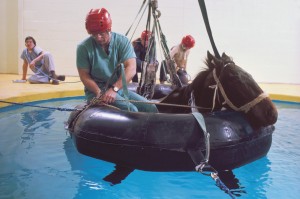
Someone who constantly practices a physical activity to stay in shape, or a sport with the intention of bettering their performance, may incur one of these misadventures: sprain, stress fracture, bursitis, plantar fasciitis, tendinitis, etc. We immediately understand what a diagnosis ending in -itis means: we have a long recovery ahead. Pain and common sense tell us to rest, ice for 15 minutes several times a day, rest, and rest some more. Usually tendons and ligaments become inflamed from the repeated stress we put on our joints and bones during performance. An injury calls for a period of rest to allow our body to begin the natural process of tissue repair. Only after this has occurred will it be possible to resume our favorite pastime again.
What can I do while I’m stuck on the couch icing and resting while my buddies are outside on a 10 mile trail run? Who can I speak to for advice on physical therapy? You might have questions like these running through your mind during the long and tedious process of trying to heal an injury. But don’t worry, we’ve got you covered.
We have a list of specialists who help athletes with their physical recovery and avoid the anxiety from not being able to run, swim or bike.
To their credit, family doctors are often able to give good information. Nevertheless, we suggest consulting a specialist. For example, an orthopedic surgeon can understand if there is a need for surgery, an osteopath or chiropractor can facilitate the alignment of the spine or oversee sessions of the Feldenkrais Method, which rehabilitates fine motor skills. They know that inflammation is not only due to joints being burdened by overuse but also from poor form. Let us proceed step by step.
Who is the orthopedist?
An orthopedic surgeon is a doctor who deals with biomechanic aspect of sports injuries: muscles, bones, tendons and ligaments. You go to an orthopedist following a severe blunt-force trauma that requires orthopedic surgery or to get information about physical therapy.
Who is the physiatrist?
The physiatrist is a doctor who has a specialization in physical and rehabilitation medicine. They decide upon the appropriate physical therapy following surgery or for the recovery of a stroke patient. They deal with all the pains and problems relating to the musculoskeletal system. The physiatrist also deals with minor traumas that do not require surgery and follows the functional recovery of a patient after an orthopedic surgery.
Who is the physical therapist?
The physical therapis is a health care professional who oversees your physical recovery. Depending on the type of problem, and what they have been told by the orthopedic surgeon and physiatrist, they will either use electro-medical equipment (Tecar, ultrasounds, magnetic therapy) or apply manual therapy and functional bandages. Through these rehabilitation sessions an athlete can restore function, improve mobility, manage pain and limit or prevent permanent disability.
Who is the physiotherapist?
This is the healthcare professional that does therapeutic massage and sports massage. According to homeopathic medicine, a normal way to proceed after an injury has occurred may include a visit to the orthopedist. He can make the necessary diagnosis, prescribe medication, make referrals to a physical therapist or suggest therapeutic massage from a physiotherapist. A physiotherapist also evaluates appropriate therapies for the treatment of joint and spine pain.
Our list of doctors and medical professionals does not stop here. Terms such as osteopathic and chiropractic have become common place and an increasing number of people regularly visit one of these professionals to find relief to their physical problems. While osteopathic physicians and chiropractors both use their hands to “cure” we would like to explore the technical details of what really sets them apart.
The osteopath
The spinal adjustments seen in both practices originate from a method established in the United States by Dr. Still in 1874. In osteopathy they are used to allow the circulation of blood to flow more freely throughout the body.
The chiropractor
The chiropractor, on the other hand, wants to attain a balance between the nervous system and the life force that flows into it in order to improve the functioning of the body and achieve healing. In 1895 Dr. Palmer founded this technique.
Both the chiropractor and the osteopath believe the body is a self healing machine. They also view symptoms as a warning and not the cause of the actual problem. In other words, they do not treat symptoms.
One noteworthy difference between osteopathic and chiropractic medicine is the treatment program. With an osteopath you can expect 3 visits of 40 minutes each. They believe this is sufficient to rebalance the body. With a chiropractor, on the other hand, you may expect around 10 treatments of 8 to 15 minutes each.
A chiropractor and an osteopath can both be used to treat a variety of maladies. They can also provide excellent preventive care or general care to improve ones well being. Those who have used both osteopathic and chiropractic methods say they have seen an improvement in their symptoms and regain joint movement in a short time.
Many professional athletes’ use of these figures not only during training but also during competition. The intervention of a “manipulator” can fit a joint or relocate a dislocated ankle, or help with the realignment of a spine.
How to choose between the two? Choosing one or the other is difficult without raising a hornet’s nest among professionals: it’s a matter of who performs the treatment as well as their particular approach that can make make a difference.
Painful and invasive manipulations will not necessarily result in an improvement or may even be counterproductive. Less invasive treatments can have the same healing affect and allow the body to recover its own balance.



 Subscribe to our newsletter to have the latest updates delivered straight to your inbox.
Subscribe to our newsletter to have the latest updates delivered straight to your inbox. TRI60 DISTANCE TRAINING
TRI60 DISTANCE TRAINING  Sportbox Training Focus Roma-Ostia Half Marathon 2019
Sportbox Training Focus Roma-Ostia Half Marathon 2019  Sportbox Training Focus Venice Marathon 2019
Sportbox Training Focus Venice Marathon 2019  t-shirt limited edition autographed by Danilo Goffi
t-shirt limited edition autographed by Danilo Goffi  Women's Sitting technical t-shirt
Women's Sitting technical t-shirt  Women's dove voglio technical t-shirt
Women's dove voglio technical t-shirt 